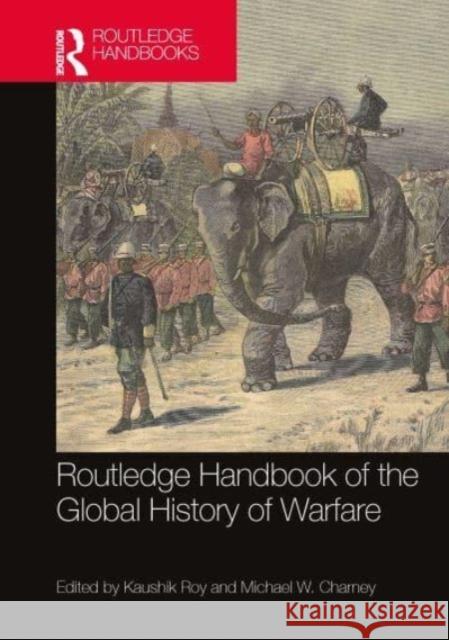HANDBOOK OF THE GLOBAL HISTORY OF W » książka



HANDBOOK OF THE GLOBAL HISTORY OF W
ISBN-13: 9781138345386 / Twarda / 2024
HANDBOOK OF THE GLOBAL HISTORY OF W
ISBN-13: 9781138345386 / Twarda / 2024
(netto: 1019,92 VAT: 5%)
Najniższa cena z 30 dni: 1032,66
ok. 22 dni roboczych.
Darmowa dostawa!
This handbook examines key aspects of the development of the global history of warfare and the changing patterns of warfare over time.
‘This is a superlative collection, bringing together some of the finest minds in the field. The essays offer both range and depth, and anyone interested in the history of war from a global perspective will want to have this volume on their bookshelves.’
Richard Reid, Professor of African History, University of Oxford
‘A Collection of great importance not only to military historians but also to those interested in global history. Conceptually alert, this volume deserves much attention.’
Jeremy Black, Emeritus Professor, Exeter University
‘In 35 chapters written by distinguished and established historians the Handbook explores warfare from the agrarian Bronze Age through to the challenges of contemporary, ‘postmodern’ conflict. The perspective is uncompromisingly global, and offers remarkable scope for comparative analysis and understanding. The volume is an invaluable and indispensable work for all military historians.’
David Parrott, Professor of Early Modern History, University of Oxford
‘This timely compendium, drawing on an impressive mix of established and emerging scholars, provides insights into the conduct and character of wars on a global scale, stretching from the earliest recorded conflicts to the postcolonial and postindustrial conflicts of today. It will quickly become a valuable platform for further scholarship.’
Douglas M. Peers, Professor of History, University of Waterloo
Introduction: The Evolution of Warfare: Global Perspectives Part I: Origins of Warfare 1. The Evolution of Bronze Age Warfare, and its Historical Significance in Western Eurasia and the Near East 2. War, Captive-Taking, and Warriors in Pre-Columbian Mesoamerica 3. Indigenous Warfare in Australia and New Zealand Part II: Polities and Armed Forces in the Pre-modern Era 4. Assyrian Warfare, 1550-609 BCE 5. The Polis and the Emergence of Hoplite Warfare 6. Transition from Roman to Merovingian Warfare: The Long Fifth Century 7. New Approaches to Late Imperial Chinese Warfare 8. Warfare in Precolonial Africa Part III: Steppe Nomads of Eurasia 9. The European Huns 10. Arab-Byzantine Warfare: 660 CE-1040 CE 11. Crusading Armies and the Turks in the Middle East 12. The Limits of Mongol Military Power 13. The Cycle of Empire in Central Asia: The Frontier and Beyond Part IV: Naval Warfare and Piracy in the Pre-Industrial World 14. The Egyptian Origins of Amphibious Warfare: Out of Africa 15. China’s Pirate Wars, 1522-1810 16. Rise of British Naval Power in the Indian Ocean Part V: The Impact of Gunpowder 17. Economy and Gunpowder Weapons in Western and Central Europe 18. Gunpowder and the Rise of Muscovy: Circa 1200--circa 1800 19. Smallpox and War in America 20. Gunpowder and the North American Indian Way of War 21. Firearms and Maritime Gunpowder States of Asia Part VI: Transition from Industrial to Total War 22. Napoleon and Mass Warfare 23. The American Civil War and the Beginning of Total War? 24. The British Army, 1870-1918: From Small War to Trench War 25. Theory and Practice of Armoured War during the Two World Wars 26. Race and Conflict in the Asia-Pacific Region: 1941-1945 27. Modern Naval Warfare: 1815-2000 28. Strategic Air Power in the Two World Wars Part VII: Wars of Decolonisation and Cold War 29. Warfare in the Middle East since 1945 30. Wars of Decolonisation in South Asia: The Indian Army, 1945-47 31. The Falklands Conflict: The Last British Imperial War? Part VIII: Postmodern/New Wars 32. The Global War on Terror: The American Operations in Afghanistan and Iraq 33. Private Military Contractors and Conflicts in the New Millennium 34. The Arms Race in Contemporary East Asia 35. Employment of Air Power in Fourth Generation Warfare: An Indian Perspective
Kaushik Roy is Guru Nanak Chair Professor in the Department of History, Jadavpur University, Kolkata, India. He specialises in warfare in Eurasia and is currently associated with the ‘Warring with Machines’ Project of the Peace Research Institute Oslo (PRIO), Norway.
Michael W. Charney is Professor of Asian and Military History at SOAS, University of London, where he teaches the history of violence, cities, and the emergence of the contemporary world. His work mainly focuses on Southeast Asia and Africa.
1997-2026 DolnySlask.com Agencja Internetowa
KrainaKsiazek.PL - Księgarnia Internetowa









